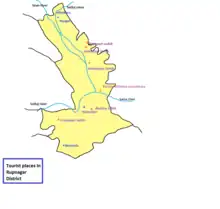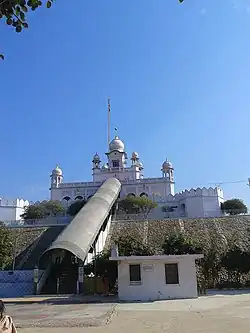Sarsa river
Sarasa river or Sirsa river (in Punjabi ਸਰਸਾ /ਸਿਰਸਾ ਨਦੀ, in Hindi सरसा,सिरसा नदी ) is a river in north India.[1]

Course
The river rises in the Shiwalik foothills of Southern Himachal Pradesh. It flows in the western part of Solan district, then enters into Punjab near Diwari village. Sarsa joins the river Sutlej at the eastern part of Rupnagar district of Punjab. It joins the Satluj River near Taraf village.
History


In December 1704, the Battle of Sarsa (a part of the Mughal-Sikh Wars) was fought between Khalsa and Mughal Empire.The river was flooded that night. Guru Gobind Singh was the tenth Sikh Guru. His family separated (vichor) during this incident and were presumed to be among the dead.
A Gurudwara named Parivar Vichora is situated near the bank of river Sirsa in the village Majri.
Pollution
Baddi, Nalagarh, Barotiwala industrial areas (in Solan district are on banks of this river. The various research reports by the Central Pollution Control Board, Himdhara (a Himachal-based watchdog) and other media reports note that industrial effluents from Baddi, Barotiwala, and Nalagarh industrial areas, including the discharge from a common effluent treatment plant, illegal dumping of garbage, and unlawful sand mining, are the chief threats to the Sirsa river.[2] The pollution has caused great damage to the aquatic life and increased fish mortality.[3][4]
References
- Dash, Pratik (28 April 2019). "Hydrological Studies in Sirsa Basin of Satluj River, Himachal Pradesh Using Remote Sensing and GIS" – via dl.bhu.ac.in.
- IANS (29 December 2018). "Himachal's Sirsa river facing ecological disaster: Green group" – via Business Standard.
- "Due To High Pollution, Sirsa River Is Facing Ecological Disaster, says a Himachal Pradesh-Based Green Group - News". ndtv.com. 31 December 2018.
- "Fish mortality reported in HP's Sirsa river in Baddi industrial area". www.indiawaterportal.org.